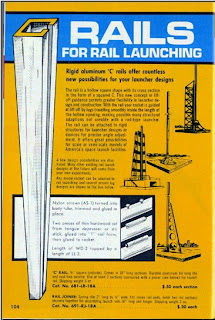The original Estes Midget kit was one of the first rockets I ever built.
In 1969 I thought $1.25 was a great price for a two stage rocket!
Before I start on this one -
This build is not the recently released Retro Repro Midget kit from Semroc and not the original Estes kit.
This is a clone kit picked up on EBAY.
I thought the price was good, under $10.00.
The new Semroc kit is only $10.00!
I should have waited for the Semroc repro! There was too many things that needed fixing to get it close.
Here are the parts received:
When I received this clone kit, I thought - How ridiculous! This model can't be flown with current 13mm "T" engines. It was a clone made for the old "S" (for short, 1 3/4" long) engine model.
It sat in the build pile until I saw how Semroc adapted 18mm engine casing adapters. A simple solution.
I cut two 1 3/4" long 18mm casings for 13mm engine adapters. To see this explained, check out the Midget instructions posted on the Semroc website.

The strange thing is, these fins were laser cut by Semroc! I could assume most all the other parts were also from Semroc.
The clone kit didn't include a parachute or a proper shroud. I wrote a note to the producer of the kit and a new Estes 12" parachute was sent.
The 20/50 shroud transition was printed on 20 lb. copy paper. I felt it was unusable. A 110 lb. cardstock print of the shroud was sent with the parachute.
To the right is the LONG dowel for a lug standoff, the laser cut launch lug and
the two, 1 3/4" 18mm casings.
The short BT-20 tube is the engine mount tube for the upper stage, probably the shortest engine mount tube I've seen in a kit.
Above it all is the 20 lb. copy paper shroud. More on that later.
To the far right are the very short 1/8" long engine blocks. One goes above the upper stage engine as normal.
The other goes below the booster engine in the first stage.



















































